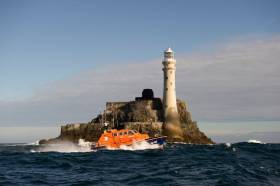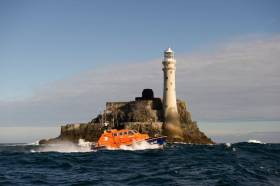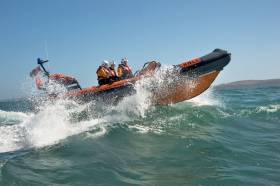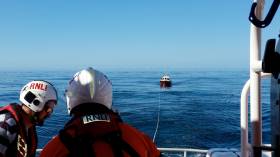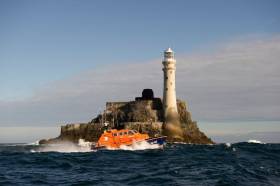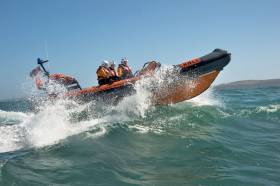Displaying items by tag: Baltimore
RNLI Lifeboats In Medevac Shouts At Baltimore & Wicklow
#RNLI - Baltimore RNLI carried out a medevac on Saturday night (12 May) from Cape Clear Island off the coast of West Cork.
The volunteer crew were requested to launch their all-weather lifeboat by the Irish Coast Guard at 8.05pm to provide medical assistance and evacuation to a man working on the island.
Arriving in Cape Clear at 8.24pm, the RNLI volunteers transferred the casualty onto the lifeboat and returned him to Baltimore lifeboat station, whee he was handed over to the care of a waiting HSE ambulance crew.
Conditions at sea during the shout were calm with a south-westerly Force 3 wind and half-metre sea swell.
“So far this year medical evacuations make up a high percentage of the call outs for Baltimore lifeboat,” said Kate Callanan, Baltimore RNLI volunteer lifeboat press officer.
“Acting as an ambulance between the islands off the coast of West Cork is a vital service and our volunteer crews are trained to a high standard in first aid and casualty care.
“If you find yourself at sea or on an island in need of medical assistance, call 999 or 112 and ask for the coastguard.”
Hours later, Wicklow RNLI’s inshore lifeboat crew were alerted by pager shortly after 3.10pm yesterday afternoon (Sunday 13 May) to assist in the medic of an injured sailor in the town’s harbour.
The sailor was being treated on a yacht by first responders and HSC paramedics at the East pier after he sustained injuries while sailing in Wicklow Bay.
The lifeboat was requested to launch in case the casualty was seriously injured and needed to be evacuated from the yacht to a more suitable location for transfer to an ambulance.
The lifeboat, with helm Alan Goucher and crew Terry Sillery and Paul Sillery, was about to launch when lifeboat operations manager Des Davitt was made aware that the casualty was assisted up a ladder onto the pier after being treated by paramedics, and no further assistance was required.
#RNLI - Baltimore RNLI launched on Monday evening (7 May) to carry out a medical evacuation for a man from Sherkin Island off the West Cork coast.
The volunteer lifeboat crew arrived on scene at 7.40pm, just eight minute after launch, and provided casualty care before transferring the patient to the all-weather lifeboat and returning to Baltimore, where he was handed over to the HSE ambulance crew at 8.30pm.
Weather conditions were good at the time, with a south-westerly Force 2-3 wind and calm sea conditions within the harbour.
The volunteer crew onboard the lifeboat were coxswain Kieran Cotter, mechanic Cathal Cottrell and crew members Pat Collins, Aidan Bushe, Jerry Smith, Eoin Ryan, Don O’Donovan and Ronnie Carty.
Speaking following the callout, Baltimore RNLI volunteer lifeboat press officer Kate Callanan said: “The RNLI and other rescue agencies around the coast provide a vital service to those living or holidaying on islands. If you require assistance, please call 999 or 112 and ask for the coastguard.”
Baltimore Lifeboat Launches To Broken Down Trawler
#RNLI - Baltimore RNLI were called out in the early hours of yesterday morning (Friday 23 March) to a fishing trawler with five people on board which had broken down close to shore.
The volunteer lifeboat crew launched their all-weather lifeboat at 5.20am after the Irish Coast Guard requested assistance for a 22m fishing trawler that had suffered engine failure close to the shoreline off the West Cork harbour’s mouth.
Arriving on scene six minutes later, the lifeboat found the casualty vessel had an anchor shot and the crew, all in lifejackets, were working to resolve their mechanical difficulties. Weather conditions at the time had a south-westerly Force 5 wind and a 1.5m sea swell with good visibility.
Within 20 minutes, the trawler was underway by its own power, under escort of the Baltimore lifeboat, to the safety of Baltimore Harbour.
Speaking following the callout, Baltimore RNLI volunteer lifeboat press officer Kate Callanan said: “If your boat is in danger close to the shoreline, always remember to try not to panic.
“Use the resources available such as deploying an anchor, ensure all people aboard are in lifejackets and seek assistance as soon as possible. If you get into difficulty at sea or on the coast, call 999 or 112 and ask for the coastguard.”
The volunteer crew on this callout were coxswain Kieran Cotter, mechanic Cathal Cottrell, Pat Collins, Davie Ryan, Colin Whooley, Aidan Bushe, Emma Lupton and Don O’Donovan. Sean McCarthy assisted at Baltimore lifeboat station.
Elsewhere on the Irish coast, Skerries RNLI launched to reports of individuals in distress on two separate occasions earlier this week.
Shortly after 4am on Monday morning (19 March), Skerries volunteers launched their Atlantic 85 inshore lifeboat after Dublin Coast Guard received a call that a person in distress had entered the water near Laytown.
The lifeboat, with Emma Wilson at the helm and crewed by Steven Johnson, JP Tanner and Paddy Dillon, had just launched the boat when they were stood down as a garda had managed to help the person ashore to a waiting ambulance.
The lifeboat launched again on Tuesday evening (20 March) shortly after 11.30pm, this time helmed by Peter Kennedy with volunteers Jack Keane, JP Tanner and Paddy Dillon on board.
Concerns had been raised about a person who was in danger of entering the water near Bettystown. Again the lifeboat was stood down shortly after launching as shore-based emergency services had taken the person into their care.
Speaking about the callouts, Skerries RNLI volunteer lifeboat press officer Gerry Canning said: “It’s been a restless start to the week for our volunteers, but they are always ready to answer any call for help.
“The most important thing is that there wasn’t a tragic outcome in either case and we hope that the casualties make a full and speedy recovery.”
Baltimore Lifeboat On 11-Hour Callout To Assist Trawler
#RNLI - Baltimore RNLI were called out on Monday afternoon (26 February) to a fishing trawler that had broken down 50 miles south of Baltimore in West Cork.
The volunteer lifeboat crew launched their all-weather lifeboat at 2.12pm after the Irish Coast Guard requested that they go to the assistance of a 24m French-registered fishing trawler, with five people on board, that had suffered engine failure.
Arriving on scene at 4.25pm, the lifeboat crew had a tow established to the casualty vessel and were proceeding back to Baltimore within 10 minutes. One of the lifeboat volunteers, Youen Jacob, is fluent in French and was able to communicate with the trawler crew for the duration of the callout.
Weather conditions at the time were difficult, with an east southeasterly Force 6-7 wind and a four-metre sea swell, but visibility was good.
During the return to Baltimore Harbour, the tow proved difficult at times due to the weight of the casualty vessel and sea conditions, and at one point, shortly before 11pm, the tow disconnected for a short time.
Due to conditions in the harbour and the size of the casualty vessel, lifeboat coxswain Kieran Cotter decided that Baltimore’s inshore lifeboat should be launched to assist in bringing the trawler alongside the pier in Baltimore.
The smaller boat launched at 11.45pm to meet the all-weather lifeboat at the harbour’s entrance and escorted the two vessels to the pier, arriving at 12.20am, and the trawler was finally manoeuvred alongside and tied up at 1.15am.
Speaking following the callout, Baltimore RNLI volunteer lifeboat press officer Kate Callanan said: “It was helpful that the Irish Coast Guard notified us in advance of launching that the fishing trawler crew had no English as we were able to choose a fluent French speaker as one of our lifeboat volunteers.
“Thanks to Youen being able to communicate between the fishing vessel and the lifeboat both crews knew what was required throughout the rescue.”
The six volunteer crew onboard the all-weather lifeboat were coxswain Kieran Cotter, mechanic Pat Collins and crew members Aidan Bushe, Sean McCarthy, Youen Jacob and Jim Griffiths. Three volunteer crew onboard the inshore lifeboat were helm Micheal Cottrell, Ryan O’Mahony and Paul Synott. Assisting at Baltimore lifeboat station were Marty O’Driscoll, Ronnie Carthy, Pat O’Driscoll, Cathal Cottrell, Kieran Collins, Colin Whooley and Simon Duggan.
Baltimore Lifeboat Provides Medevac From Sherkin Island
#RNLI - Baltimore RNLI launched yesterday afternoon (Sunday 7 January) to provide a medical evacuation from Sherkin Island.
The volunteer lifeboat crew launched their all-weather lifeboat following a request from the Irish Coast Guard at 3.50pm to provide medical assistance and evacuation for an elderly man on the West Cork island.
Once on scene, the volunteer lifeboat crew administered casualty care before transferring the patient back to the all-weather lifeboat, which returned to Baltimore lifeboat station at 4.20pm to transfer the patient to the care of the waiting HSE ambulance crew.
There was a north-easterly Force 4-5 wind at the time but sea conditions within the harbour were calm.
Speaking following the callout, Baltimore RNLI volunteer lifeboat press officer Kate Callanan said: “The RNLI and other rescue/emergency agencies provide a vital service to those living or staying on islands around the coast of Ireland. If you are in difficulty on or near the coastline call 999 or 112 and ask for the coastguard.”
There were eight volunteer crew onboard the lifeboat: coxswain Kieran Cotter, mechanic Cathal Cottrell and crew members Brendan Cottrell, Jerry Smith, Don O’Donovan, Kieran Collins, Micheal Cottrell and Eoin Ryan. In attendance at the lifeboat station was Kate Callanan.
Last weekend, Baltimore RNLI launched twice in the same day for a medevac from Heir Island and to assist bodyboarders reported in difficulty at Barleycove, as previously reported on Afloat.ie.
#RNLI - Baltimore RNLI launched twice in the space of a few hours yesterday (Friday 29 December) — firstly to provide a medevac from Heir Island, and later to assist bodyboarders in difficulty at Barleycove.
The volunteer crew launched their all-weather lifeboat Alan Massey following a request from the Irish Coast Guard at 11.16am to provide medical assistance and evacuation to a woman who fell on Heir Island off the coast of West Cork.
Once on scene, the crew administered casualty care before transferring the patient to the all-weather lifeboat and returning to Baltimore to meet a waiting HSE ambulance crew.
Conditions at sea during the shout had a north-westerly Force 6-7 wind and a one-metre sea swell, heralding Storm Dylan’s approach this weekend.
The crew launched a second time, at 4.18pm, after a member of the public alerted that three bodyboarders were in difficulty off Barleycove, near Mizen Head in West Cork.
The wind had eased considerably since the first callout, with a south-westerly Force 3-4, but there was a rough sea state with a swell of 3-4m.
At 4.45pm, with the lifeboat four miles west of West Calf Island, the crew were asked to stand down by the Irish Coast Guard after the three bodyboarders had made it safely ashore.
Speaking following the callouts, Baltimore RNLI volunteer lifeboat press officer Kate Callanan said: “With strong winds forecast over the coming days, the Irish Coast Guard strongly advises to exercise caution in coastal areas and reminds people to ‘Stay Back, Stay High and Stay Dry’.
“If you see someone in difficulty in the sea of along the shore call 999 or 112 and ask for the coastguard.”
The volunteer crew on the first callout were coxswain Kieran Cotter, mechanic Jerry Smith and crew members Aidan Bushe, Don O’Donovan, Simon Duggan and Kieran Collins. Ay the lifeboat station were Kate Callanan and John O’Brien. Crew on the second callout were Cotter, Smith, Bushe, O’Donovan, Eoin Ryan and David Ryan.
Baltimore Lifeboat Assists Yacht In High Winds
#RNLI - Baltimore RNLI’s inshore lifeboat Patricia Jennings was called on Sunday (1 October) to go to the assistance of a 28ft yacht with one person on board.
The yacht had lost power near the West Cork harbour's west pier and was in danger of drifting ashore amid Force 7 westerly winds.
The skipper of the yacht had thrown out his anchor which was holding it in position, but without power was unable to get away from the vicinity of the shore.
The alarm was raised by a another vessel, also with one on board, which was standing by but unable to assist.
Under helm Kieran Collins and crew Jerry Smith and Colin Rochford, the lifeboat immediately launched and was in scene within 15 minutes of alarm being raised.
One crew member was put on board to assist the casualty. A tow was then rigged and the yacht was towed to safety.
Also responding to the callout were Ian Lynch and Youen Jacob. Ronnie Carthy, Kieran Cotter and Colin Whooley acted as shore crew.
West Cork Lifeboats Launch To Stranded Tug & Angling Boat
#RNLI - Lifeboats from Baltimore and Castletownbere launched two separate callouts off West Cork since Friday (1 September).
Baltimore RNLI was called out yesterday morning (Saturday 2 September) to a tug with three people on board, which had broken down north of Drowlaun Point off Sherkin Island.
The volunteer crew launched their all-weather lifeboat at 9.45am after they were alerted by the skipper of the 12.5m tug. They arrived on scene seven minutes later and quickly established a tow to Baltimore Harbour within an hour.
Conditions at the time were good, with a southerly Force 4-5 wind and a calm sea ahead of the much poorer weather forecast for later in the day.
Elsewhere, Castletownbere RNLI lifeboat was launched on Friday morning to a 30ft angling boat with mechanical failure three miles south-east of Crow Head on the Beara Peninsula.
The lifeboat, under the command of Coxswain Brian O’Driscoll, was launched on service within minutes and proceeded to the casualty some nine miles southwest of Castletownbere Harbour.
The casualty was located in fine weather conditions at 11.07am. RNLI volunteers passed a towrope to the anglers’ onboard and the lifeboat took the vessel under tow to Castletownbere, where it was berthed alongside the pier 90 minutes later.
Baltimore Lifeboat Launches To Boat Aground In Heavy Fog
#RNLI - Baltimore RNLI launched in the early hours of yesterday morning (Thursday 17 August) after a boat ran aground in heavy fog near the West Cork village.
The volunteer lifeboat crew were paged at 00.39am to assist the 50ft vessel with three people on board. Sea conditions in the area were calm, but visibility was poor due to fog.
Under the command of coxswain Kieran Cotter and with mechanic Cathal Cottrell and crew members Pat Collins, Kieran Collins, Don O’Donovan, Jerry Smith and Micheal Cottrell, the lifeboat reached the vessel within 15 minutes.
After assessing the grounded boat’s situation and checking the surrounding area for any navigational hazards, a tow was established and the vessel was pulled clear.
There was no apparent damage to the vessel and no injuries to anyone on board, so it was allowed to move under its own power Baltimore Harbour, where it arrived escorted by the lifeboat at 1.20am.
Speaking following the callout, Baltimore RNLI volunteer lifeboat press officer Kate Callanan said: “With bad weather forecast for the next few days we would remind everyone taking to the sea to respect the water.”
Earlier in the week, Baltimore RNLI launched on Tuesday night (15 August) after reports of a flare sighted at Gokane Point, near Toe Head.
However, the lifeboat was stood down en route when the Irish Coast Guard learned that the flare was actually a firework set off from land and not a boat in distress.
Elsewhere, Arklow RNLI’s volunteers launched yesterday afternoon following a pager alert to a call for help from a sailing vessel with engine trouble.
In moderate seas, the lifeboat Ger Tigchlearr proceeded to the reported position of the casualty vessel, some four miles north east of Arklow Harbour and with two people on board.
Once on scene, the vessel and crew of the casualty vessel were found be in good order, and a towline was established it bring the boat back to Arklow.
John Tyrrell, Arklow RNLI’s lifeboat operations manager, commented: “Our crew were able to get the casualty vessel in a timely fashion. We would like to commend the skipper of the boat for calling for help at an early stage.”
#RNLI - Baltimore RNLI assisted two sailors yesterday evening (Monday 14 August) after their yacht lost power off Mizen Head in West Cork.
The alarm was raised earlier in the afternoon following a report from the crew of a 26ft yacht that they had lost all battery power.
At the time, the occupants were comfortable sailing the yacht towards Baltimore, so the lifeboat was put on standby until they were closer.
However, due to a confused sea in a strong tideway, the yacht was making very little progress towards land and required assistance to get to port.
The inshore lifeboat, helmed by Micheal Cottrell and with crew members Ryan O’Mahony and Colin Rochford on board, left station at 7.20pm and met the yacht three miles west of Cape Clear Island just before 8pm.
Weather conditions at the time were relatively good, with a Force 3 south-westerly wind and a one-metre sea swell.
One of the lifeboat crew went aboard the yacht to assist with rigging a tow and, once that was established at 8.05pm, a course was set for North Harbour in Cape Clear where the vessel was moored safely at 8.55pm.
Speaking following the callout, Cottrell said: “The sailors did the right thing in initially alerting people ashore to their predicament and then seeking the assistance of the lifeboat before darkness when their situation wasn’t improving.”



























